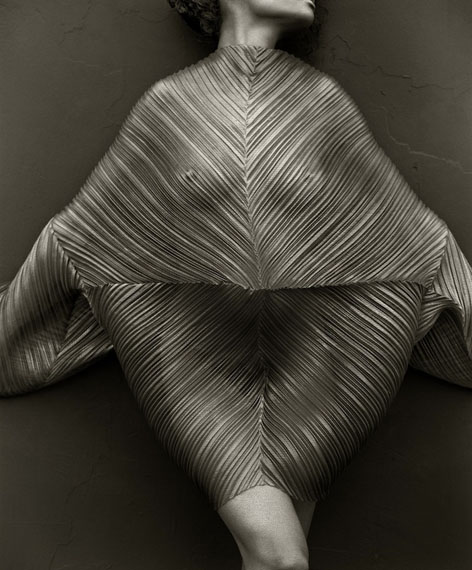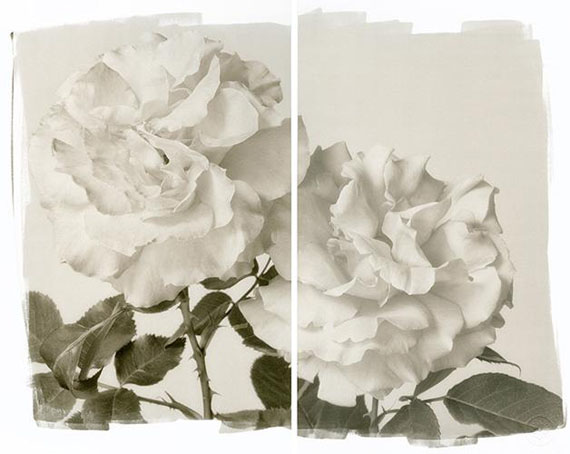
WRAPPED TORSO, Los Angeles, 1989
Platinum Print, 50.8 x 40.6 cm
Platinum
Nick Brandt » Brigitte Carnochan » Horst P. Horst » Barry Lategan » Silke Lauffs » Irving Penn » Len Prince » Mirella Ricciardi » Herb Ritts » Mark Seliger » Gregor Törzs » George Tice »
Exhibition: 20 Sep – 31 Oct 2013
Thu 19 Sep 19:00 - 21:00

Bernheimer Fine Art Photography
Brienner Str. 7, 1. Stock
80333 München
+49 (0)89-226672
photo@bernheimer.com
www.bernheimer.com/photography/
Tue-Fri 10-18, Sat 11-16

TWO ROSES, 2011
Platinum Palladium Print
PLATINUM
20th of September to 31st of October 2013
Opening: 19 September 2013, 7 - 9 p.m.
This Autumn Bernheimer Fine Art Photography is presenting an exhibition of museum quality: PLATINUM is a group exhibition highlighting the most valued of all photographic images. Platinum prints offer the ultimate in photographic permanence coupled with a subtle tonal range and a tactile quality of the image made on handmade paper. This exhibition presents finest examples of the works of masters such as Irving Penn, Horst P Horst, Herb Ritts and Mark Seliger. Platinum prints are loved by photographers and treasured by collectors and investors because of their special tones, the surface quality and their permanence. The unique beauty of a fine platinum print involves a broad scale of tones from black to white. The delicate, rich platinum tones range from warm black, to reddish brown, to expanded mid tone greys that are unobtainable in silver prints. In the deepest shadows the platinum print still presents information; the depth of the image is alive and three-dimensional.
Platinum prints are not only exceptionally beautiful, they are the most durable of all photographic processes. The platinum metals are more stable than gold, and it is estimated that a platinum image, properly made, can last thousands of years.
The nature of this process provides another distinctiveness, even within a short edition of the same image, each print carries diverse subtleties making it a unique interpretation in itself. This handcrafted printing process is far removed from the world of mass produced silver-based papers and modern supports for digital outputs. In platinum printing there is no reliance of factory prepared materials, each print of an edition being executed individually as though is was the only example of that image, an unrepeatable dialogue between the image, the chemistry and the printer's skill. Invented by William Willis in 1876 the process became popular during the 19th century; the Pictorialists, a group of photographers active primarily between the years 1880 to 1920, worked using the Platinum process extensively because of its delicacy and its potential for expressing the characteristics of more traditional art making methods such as drawing and etching.
The process virtually disappeared during World War I when platinum was diverted to the war effort - the cost became prohibitive. Due to its ease of manufacturing, availability and cost, silver became the dominant light sensitive material, a fact that continues to this day. Where once there had been 20 commercial companies supplying platinum paper, by 1930 the last company went out of business. Modern platinum printing is an entirely handmade process. It begins by preparing a light sensitive solution, which contains platinum and palladium salts. This solution is brushed onto specially selected art paper, dried and exposed in contact with a negative to ultraviolet light. The exposed paper is placed in a developer, where metal salts are reduced back to a metallic state forming the image. It is then carried through a series of clearing baths. The print that emerges from the final wash consists of nothing but particles of precious metals permanently embedded in the fibers of the paper. Since the early 1960s, American photographer Irving Penn made a limited number of platinum prints of his most celebrated photographs. A meticulous craftsman, Penn experimented extensively to make prints with remarkably subtle, rich tonal ranges and luxurious textures. Through his work the Platinum printing process became popular once more. A number of artists followed his example to present some of their most iconic images. In particular the fashion photographers enjoyed the richness of Platinum prints, Horst P.Horst selected his most iconic images, as well as Herb Ritts, who chose the platinum printing process to give some of his fine images a significantly wider range of tones and a luxurious matte surface.
Barry Lattegan and laterMark Seliger were also among the artists who wished to emphazise the importance for their photographs as works of art rather than picturesonly taken forthereproduction in magazines.Works by these masters will be on display at Bernheimer Fine Art Photography.
The making of a Platinum print is an art form in itself. Most of the photographers who choose to have their pictures printed in this method select only their most treasured, valued and loved pictures to be presented in this way. Only very few masters remain worldwide capable of printing in this highly delicate and elaborate manner. Bernheimer Fine Art Photography will exhibit prints of the most renown printing experts from London and New York specially made for their exhibition.
There are also a few younger artists who have been interested in the Platinum printing process, deliberately turning away from the digital outputs of our times and making this handmade process part of their art work. Gregor Törzs has turned his studio in Berlin into a laboratory to specialise in this printing technique. The photographer personally platinum prints each photograph in his own studio and he considers the printing process, as well as choosing the matching distinctive paper, part of his art.
From the beginning of 2013 Bernheimer Fine Art Photography is the only gallery representative of Gregor Törsz in Europe. In the PLATINUM exhibition his work is presented for the first time within the gallery's premises.
All of these photographers aim to not only take a good picture, but to make their most valued pictures into a precious print and thus highlight the ornate aesthetic of their art works.
The exhibition PLATINUM will present works by Irving Penn, Horst P. Horst, Herb Ritts, Mark Seliger, Len Prince, George Tice, Brigitte Carnochan, Mirella Ricciardi, Nick Brandt, Silke Lauffs and Gregor Törzs.�

HUDSON RIVER PIER, Jersey City, New Jersey, 1979
Platinum Palladium Print
PLATINUM
20. September bis 31. Oktober 2013
Ausstellungseröffnung: 19. September 2013 von 19:00 bis 21:00 Uhr
Vom 20. September bis 31. Oktober 2013 zeigt Bernheimer Fine Art Photography in der Brienner Strasse 7 in München eine Gruppenausstellung von musealem Charakter. Vorgestellt werden herausragende Photographiekünstler des 20. und 21. Jahrhunderts, deren Werke in der speziellen Technik der Platinum-Handabzüge gefertigt wurden. Zu sehen sind u.a. Arbeiten von Irving Penn, Horst P. Horst, Herb Ritts, Mark Seliger und Gregor Törzs.
Ein Platinum Abzug unterscheidet sich wesentlich von anderen schwarz-weiß Handabzügen: Zunächst ist die Beständigkeit der Abzüge im Vergleich mit allen sonstigen Arbeiten auf Papier unerreicht. Ein solcher Abzug verliert mit der Zeit nicht an Intensität oder nimmt Schaden durch das Einwirken von Licht. Die Chemikalien werden für einen Platinum-Abzug mit einem Pinsel auf ein handgemachtes Papier eingearbeitet und liegen nicht, wie bei herkömmlichen schwarz-weiß Bildern, in einer Emulsion auf dem Papier auf. Das Papier wird für jeden einzelnen Abzug von Hand bearbeitet. Das heißt auch, dass ein solcher Abzug einen Unikatcharakter erhält, selbst wenn von einem Negativ mehrere Bilder gemacht werden. Auch in einer Edition trägt jeder einzelne Abzug gewisse unterschiedliche Feinheiten, denn ein so aufwändig hergestellter Handabzug kann niemals mit einem anderen identisch sein.
Zudem ist die Tonalität in den Grauabstufungen eines Platinum Abzugs im Vergleich zu einem Silbergelatine-Abzug um ein vielfaches reicher; in diesen sind die Graustufen so fein, dass selbst in dunklen Bereichen noch eine Zeichnung erkennbar ist. Gerade im Zeitalter der digitalen Photographie werden diese Merkmale der Platinum-Abzüge bei Kennern und Sammlern aufs Höchste geschätzt.
Das Verfahren der Platin-Abzüge wurde 1873 von William Willis entwickelt und war für viele der bekanntesten Photographen des 19. Jahrhunderts lange Zeit die beliebteste Art ihre Bilder zu entwickeln. Platin war jedoch sehr teuer und später kaum noch zu bekommen, da es zur Zeit des 1. Weltkrieges nur noch für die Herstellung von Waffen gebraucht werden durfte. Bald wurde diese Technik von günstigeren und weniger zeitaufwändigen Verfahren ersetzt und geriet immer mehr in Vergessenheit.
Erst in den 1960er Jahren wurde Irving Penn auf die Methode der Platinum-Abzüge aufmerksam und erlernte anhand alter Aufzeichnungen von William Willis den Prozess autodidaktisch. Er war fasziniert von der unvergleichlichen Qualität, ästhetischen Schönheit und Besonderheit der Ergebnisse dieser Arbeit und machte diese wieder populär. Seinem Beispiel folgend, veredelten einige der großen Modephotographen des 20. Jahrhunderts ihre herausragenden Arbeiten in dieser speziellen Technik.
Horst P. Horst wählte seine bekanntesten Bilder aus und ließ diese in Platin entwickeln, ebenso wie in späteren Jahren Mark Seliger und Barry Lategan, die ihren Motiven als Platinum Abzug einen neuen Kunstcharakter verliehen. Der große Modephotograph der 80er Jahre Herb Ritts wählte nur wenige Beispiele seiner wichtigsten Werke, um diesen in Platin eine weichere, subtilere Ästhetik zu geben. Erstmals werden in dieser Ausstellung seine Werke bei Bernheimer zu sehen sein.
Die Herstellung von Platinum-Abzügen ist eine eigene Kunst und wird von den Photographen meist für ihre besonderen, ihre besten oder liebsten Bilder gewählt, wie ein Schmuckstück, das man veredelt. Dennoch gibt es weltweit nur noch wenige Photolabore, die dieses aufwändige Verfahren noch beherrschen und für einige wenige Künstler arbeiten. In der Ausstellung der Galerie Bernheimer werden Werke gezeigt, die bei den renommiertesten zeitgenössischen Spezialisten in New York und London eigens gefertigt wurden.
In den letzten Jahren haben sich auch ein paar junge Künstler von dieser besonderen Technik inspirieren lassen, um sich ganz bewusst von den digitalen Medien abzuwenden und die Handarbeit dieser Photographietechnik wieder selbst zu erlernen.
Gregor Törzs etwa, hat sich in seinem Berliner Studio auf diese Technik spezialisiert, die er ebenso wie das jeweilige Papier, das er für seine Arbeiten wählt, als einen ganz wesentlichen Teil seiner Kunst versteht. Seit Anfang diesen Jahres ist Gregor Törzs exklusiv bei Bernheimer Fine Art Photography vertreten und in der Ausstellung PLATINUM werden seine Werke erstmals in der Galerie vorgestellt.
All diesen Photographen geht es nicht nur darum, ein gutes Motiv aufzunehmen, sondern Sie veredeln durch diesen Prozess ihre eindrucksvollsten Bilder. Platinum stellt in besonderem Maße die künstlerischen Aspekte der Motive in den Vordergrund und bewahrt sie für die Ewigkeit.
In der Galerie Bernheimer in München werden diesen Herbst Platinum-Bilder von Irving Penn, Horst P. Horst, Herb Ritts, Mark Seliger, Len Prince, George Tice, Brigitte Carnochan, Mirella Ricciardi, Nick Brandt, Silke Lauffs und Gregor Törzs gezeigt.�

JOHNNY CASH, Las Vegas, 1992
Platinum Palladium Print, 70 x 60 cm

TWIGGY, London, 1966
Platinum Palladium Print, 80 x 65 cm